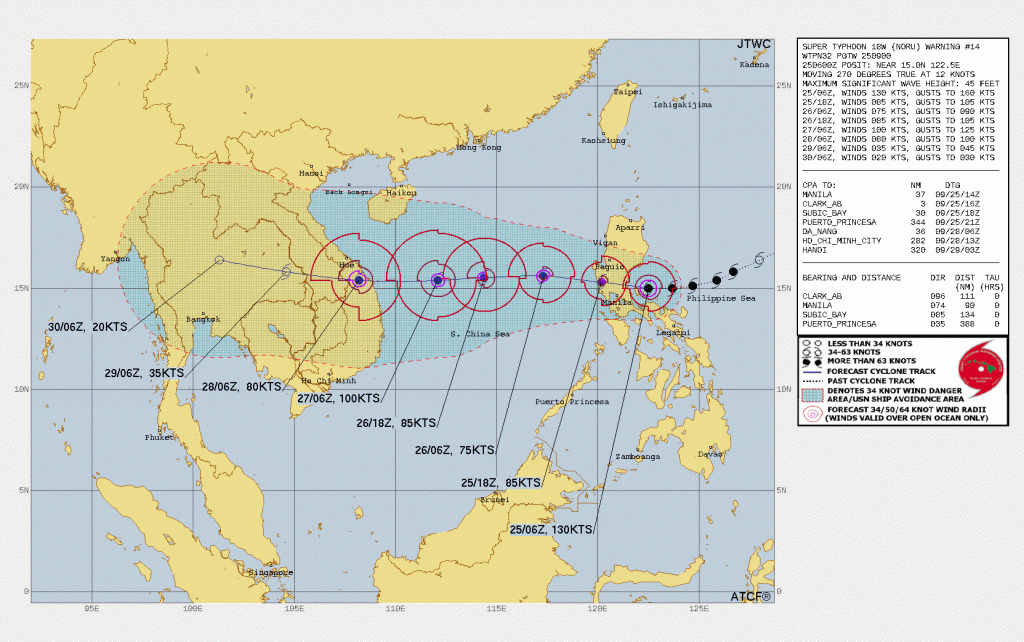Super typhoon Noru a potential threat to Philippines catastrophe bond

In the space of just 24 hours, typhoon Noru has explosively intensified into super typhoon Noru as it approaches the Philippines and now packing sustained winds of more than 150 mph the storm is a potential threat to the countries World Bank facilitated catastrophe bond.
Meteorologists have been surprised by super typhoon Noru, which is locally known as typhoon Karding in the Philippines, as the storm has rapidly intensified, with its sustained winds increasing almost 100 mph in just 24 hours, while its minimum central pressure plummeted by 76 hPa, from 995 to roughly 919 hPa.
The JTWC currently has super typhoon Noru (Karding) with sustained winds of over 150 mph, some agencies have it at 160 mph, as it approaches Luzon in the Philippines.
Gusts are higher, with the JTWC saying wind gusts from super typhoon Noru could be close to 190 mph.
You can see super typhoon Noru’s latest position and forecast track below:
Super typhoon Noru’s route across the Philippines will take it close to highly populated areas, with the capital city Manila likely to feel the effects of typhoon strength winds and significant rainfall.
At such intense wind speeds, super typhoon Noru is a significant threat to the Philippines, in damage and loss of life terms.
A rapidly intensifying storm of this kind poses a different threat as those in its path may not have made the preparations they would normally do for a super typhoon, as just 24 hours ago typhoon Noru (Karding) was not being treated as all that dangerous a storm.
Now on its final approach, super typhoon Noru looks set to deliver a devastating blow to the communities in its path, and will widely impact Luzon being a large storm.
At such intense wind speeds, super typhoon Noru becomes the latest storm to put investors and cat bond fund managers holding the World Bank issued IBRD CAR 123-124 catastrophe bond on alert.
The World Bank through its International Bank for Reconstruction and Development (IBRD) issued two Capital-At-Risk Notes Series, 123 and 124, in late 2019, with the resulting catastrophe bond providing the Republic of the Philippines with $225 million of insurance protection against impacts of earthquakes and tropical cyclones, $150 million of which was solely for tropical cyclone coverage.
The protection is delivered using a modelled loss trigger, which as a result makes it impossible to predict whether a strong cyclone like Super typhoon Rai could result in a significant threat to the investors holding the notes.
The Philippines catastrophe bond has already experienced one payout after a super typhoon, Rai, with the Philippines government receiving a US $52.5 million payout of the cat bonds principal, representing a 35% payout of its $150 million Class B cyclone risk exposed cat bond notes.
The cat bond covers tropical cyclone winds and rains, with the wind trigger typically the first to be calculated, after which rainfall amounts are run through the model as well.
The cat bond has been subject to calculation processes for tropical storm Megi (locally known as storm Agaton) earlier this year as well, but as we reported no additional payout was due for that storm.
So, as super typhoon Noru approaches, the Philippines has $97.5 million in catastrophe bond principal outstanding to provide cyclone protection against the storm.
If Noru maintains strong typhoon wind speeds, it seems likely the Philippines World Bank catastrophe bond will go through another calculation process, to identify whether its modelled loss parametric trigger has been activated by this storm, a process that will take some weeks.
Right now though, all thoughts are with the Philippines and the people in the path of super typhoon Noru, which is likely to deliver a damaging blow to the country in the landfall region.
After the Philippines, typhoon Noru is forecast to head for Vietnam and strengthen again into a strong typhoon, which could add to the eventual insurance and perhaps reinsurance market impacts from this storm.





